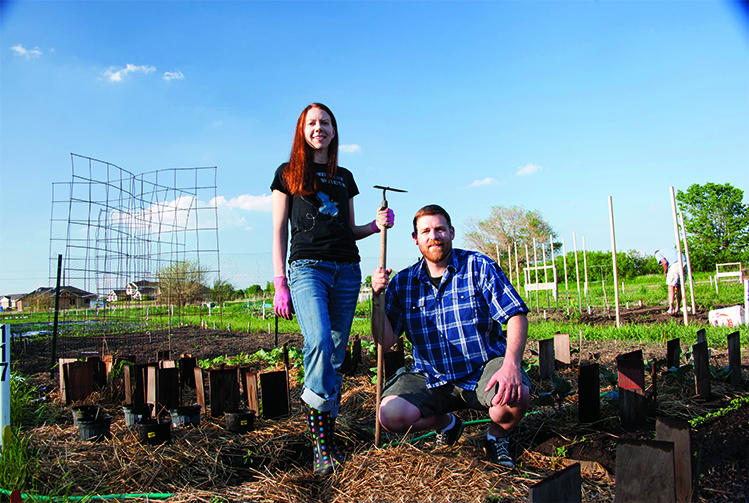The Gift of South Dakota
Subscriptions to South Dakota Magazine make great gifts!
Subscribe today — 1 year (6 issues) is just $29!
Trial and Error at the Community Garden
 |
| The Johnsons hone their gardening skills in Yankton's community garden. |
Our lawn is too shady to grow vegetables, so my husband and I sow our seeds in a community garden established on the west side of Yankton. Community gardening is fairly young in Yankton, but it has a long history, beginning in Detroit in the 1890s. The federal government promoted community gardens during World War I to supplement the food supply. Gardens fed the unemployed during the Depression, and the federal victory garden campaign during World War II encouraged patriotism and built morale. Interest dwindled after the war, then resurged in the 1970s. Community gardens have been growing ever since (pun intended).
South Dakota State University Extension agents coach groups interested in starting a community garden and there are several across our state, each one a little different than the next. Lead’s Mile High Community Garden, organized by NeighborWorks Dakota Home Resources, has 12 plots in an abandoned neighborhood near the edge of Homestake Mine. The Standing Rock Native Gardens Project hopes to prevent Type 2 diabetes by reclaiming traditional Lakota foods. And the Montrose and Murdo Horizons groups grow produce for those in need.
A committee promoting healthy lifestyles started Yankton’s garden. We joined the inaugural year, leasing two 12-by-18-foot plots for $20 each. Mark Hunhoff, a local machinery dealer, tills the soil at the start of the season and water is free — just bring your own hose. Each plot is marked with a plank painted with sayings like, “God made rainy days so gardeners could get the housework done,” or “You can bury a lot of troubles digging in the dirt.” My husband’s favorite is “I was determined to know beans.”
Jeremy and I started without horticultural skills, and we’re still not master gardeners, but we’ve learned a few tricks while digging in the dirt. For example, when planting leave more space between plants than you think you’ll need. And even if it seems wasteful, thin seedlings early and generously. Thinning and weeding is satisfying because of the tidy results, but if you squat for a long time you will get a serious head rush when you stand. Sit, kneel or bend over.
Once plants are in, you’ll become preoccupied with weather. Like farmers, I now start casual conversations with “Did it rain last night?” or “Have you heard if it’s supposed to storm?” I attribute this to my quest to “water evenly.” Zucchini and beets grow funny shapes and tomatoes get blossom end rot if you don’t. I wasn’t initially sure what “water evenly” meant. Apply water evenly to the ground? Don’t stand on one foot with the hose? My friend Tamme Klutman from Green 4 Ever in Sioux Falls explained it for me. Water every day when hot and dry. If it’s mild, water every other. About a gallon for most plants works best. Blossom end rot is caused by lack of calcium. “When the soil is too wet, the plant can't absorb it and when the soil is too dry, the plant can't absorb it, either,” Klutman says. So don’t over soak and don’t go bone dry in between.
After you get a watering rhythm, watch for bugs. Though Sneak Some Zucchini on Your Neighbor’s Porch Day implies otherwise, zucchini isn’t foolproof. My first attempt contracted vine borers. I performed surgery, slicing the base of the plant to dig out grubs, but the plant never fully recovered. Now I watch for moths fluttering around and eggs on stems and leaves. You can remove the parts of the plant with eggs. Organic pesticide helps, too.
And once mid-summer hits, always bring a bag or bucket to your plot. Even if you think nothing will be ready, your garden is likely to surprise you with a small harvest.
Editor’s Note: This story is revised from the July/August 2014 issue of South Dakota Magazine. To order a copy or to subscribe, call (800) 456-5117.










Comments